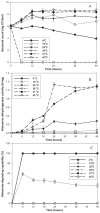Degradation of histamine by Bacillus polymyxa isolated from salted fish products
- PMID: 28911502
- PMCID: PMC9345454
- DOI: 10.1016/j.jfda.2015.02.003
Degradation of histamine by Bacillus polymyxa isolated from salted fish products
Abstract
Histamine is the causative agent of scombroid poisoning, a foodborne chemical hazard. Histamine is degraded by the oxidative deamination activity of certain microorganisms. In this study, eight histamine-degrading bacteria isolated from salted fish products were identified as Rummeliibacillus stabekisii (1 isolate), Agrobacterium tumefaciens (1 isolate), Bacillus cereus (2 isolates), Bacillus polymyxa (1 isolate), Bacillus licheniformis (1 isolate), Bacillus amyloliquefaciens (1 isolate), and Bacillus subtilis (1 isolate). Among them, B. polymyxa exhibited the highest activity in degrading histamine than the other isolates. The ranges of temperature, pH, and salt concentration for growth and histamine degradation of B. polymyxa were 25-37°C, pH 5-9, and 0.5-5% NaCl, respectively. B. polymyxa exhibited optimal growth and histamine-degrading activity at 30°C, pH 7, and 0.5% NaCl in histamine broth for 24 hours of incubation. The histamine-degrading isolate, B. polymyxa, might be used as a starter culture in inhibiting histamine accumulation during salted fish product fermentation.
Keywords: Bacillus polymyxa; histamine; histamine dehydrogenase; histamine-degrading bacteria; salted fish product.
Copyright © 2015. Published by Elsevier B.V.
Conflict of interest statement
All authors declare no conflicts of interest.
Figures



References
-
- Taylor SL. Histamine food poisoning: toxicology and clinical aspects. Crit Rev Toxicol. 1986;17:91–117. - PubMed
-
- Lin CS, Liu FL, Lee YC, Hwang CC, Tsai YH. Histamine contents of salted seafood products in Taiwan and isolation of halotolerant histamine-forming bacteria. Food Chem. 2012;131:574–9.
-
- Zaman MZ, Bakar FA, Selamat J, Bakar J. Occurrence of biogenic amines and amines degrading bacteria in fish sauce. Czech J Food Sci. 2010;28:440–9.
-
- Kim JH, Ahn HJ, Jo C, Park HJ, Chung YJ, Byun MW. Radiolysis of biogenic amines in model system by gamma irradiation. Food Control. 2004;15:405–8.
LinkOut - more resources
Full Text Sources
Other Literature Sources
Molecular Biology Databases
